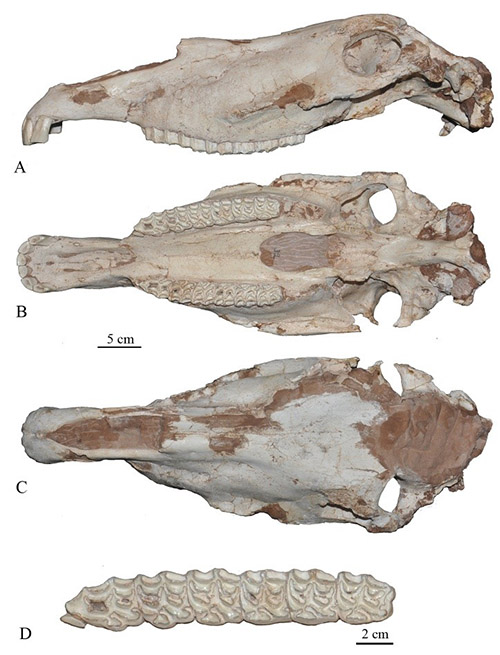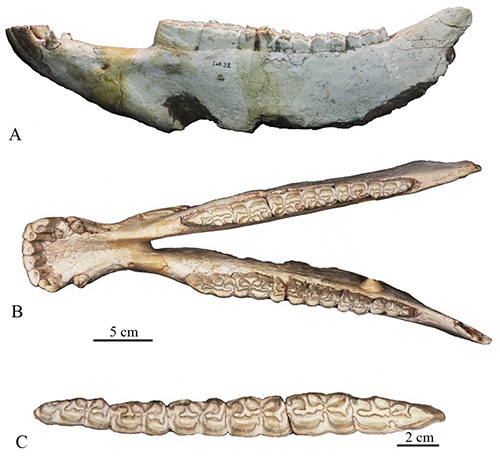| Location: Home > Research > Research Progress |
| New progress of research on fossil Equus |
|
Stenonid horse is the earliest Equus in Eurasia. The first occurrence of stenonid horse in Eurasia was regarded as the sign of the lower boundary of the Quaternary. The appearance, evolution and dispersal of the stenonid horses were contemporary with many important geological and environmental events, so they were regarded as important material for study on climatic and environmental changes in Quaternary, which fascinate paleontological researchers all over the world. China is a country where the Equus fossils are abundant. In the early 20th century, many famous paleontologists studied Equus fossils from China. In 1935, Austrian paleontologist Zdansky published first monograph of Equus fossils in China. He described Equus fossils from Hebei, Henan, Shanxi, and Shandong, and identified all the stenonid specimens as Equus cf. sanmeniensis. These fossils were collected by Swedish geologist Andersson who was engaged as a mining advisor to the Ministry of Agriculture and Commerce of the Chinese government in that time. Later these fossils were sent to Uppsala, Sweden, formed a part of the Lagrelius Collection, the largest Chinese fossil collection kept abroad. It is no doubt that Zdansky’s monograph on such a classical collection has great scientific significance. However, it is not so proper to ascribe so many specimens with different sizes and features. Headed by research project group of Dr. Deng Tao, a research team of Institute of Vertebrate Paleontology and Paleoanthropology, Chinese Academy of Sciences rediscovered Equus fossils in the Lagrelius Collection. They recognized two specimens from Qixian, Shanxi (Andersson Loc. 32) as two species other than Equus sanmeniensis in the collection, Equus teilhardi and Equus qingyangensis. Recently the research result has been published in Historical Biology on online version. E. teilhardi is not well recognized because of rare material. Its holotype is a broken mandible. Although other authors reported some supplemental material, all of them are just fragmental skull, teeth and metapodials, which is not so helpful for recognition on this species. The skull from Qixian is the first record of complete skull of E. teilhardi. It provides not only the cranial and facial features such as elongated facial part, undulated lateral view, moderately retracted nasal notch and clear preorbital fossa, but also the basilar length and basicranial proportion. This shows that E. teilhardi is a medium-sized stenonid horse with relatively short limbs and a basicranial proportion same as Equus sammeniensis. E. teilhardi was considered a very specialized species with an unknown taxonomic position because of its lower incisors lacking cup. In this research, based on the new material which only has left I3 with incomplete cup and some specimens of E. simplicidens, the most primitive Equus referred to, authors conclude that incomplete or absent cup on incisor is a unstable feature and likely derived from primitive taxon. The other species reported in this research is E. qingyangensis. The material is a broken mandible which is identical to the previously found specimens in Qingyang, Gansu. Consequently, Qixian is the second locality where E. qingyangensis and E. teilhardi coexisted. The morphology showed from the skull of E. teilhardi is significantly different from E. qingyangensis, which perfectly interprets that peacefully coexistence of these two species is due to different niches. E. qingyangensis is the most primitive stenonid horse in Eurasia. It has some morphological similarities shared with E. simplicidens, the ancestral type of all Equus. However, its advanced limbs and coexistence with E. teilhardi refute the ancestral relation between these two species. Some stenonid species in Eurasia have small to moderate body size, incisor with incomplete cup and short limb, such as Equus yunnanensis in China and Equus stehlini in Europe. They likely have close relation with E. teilhardi. The evolution of Equus is very complicated and leave researchers many question to answer. However, this is why research on Equus is so charming. The first author of this research is Sun Boyang, a PhD candidate of Institute of Vertebrate Paleontology and Paleoanthropology, Chinese Academy of Sciences. This work was supported by the National Natural Science Foundation of China, the Strategic Priority Cultivating Research Program, CAS, and the Key Research Program of Frontier Sciences, CAS.
Fig.1. Distribution of Equus teilhardi and Equus qingyangensis in China.
Fig.2. Skull of Equus teilhardi.
Fig.3. Mandible of Equus qingyangensis. |


